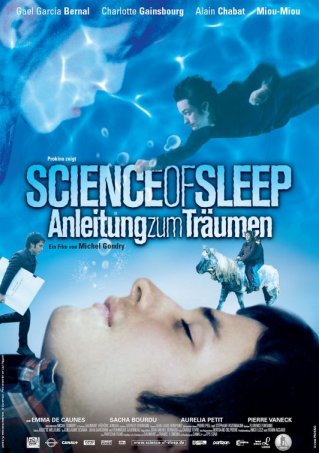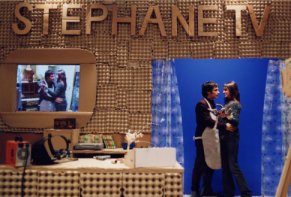|
The
Science of Sleep
I just
finished screening Michel Gondry’s latest film, The
Science of Sleep, and my head is still spinning. The
premise is simple enough. Stéphane (Gael García
Bernal) arrives in France after having been set up with
a graphic design job by his mother Christine (Miou-Miou).
Upon
arrival, Stéphane finds that he will be living in
his childhood bedroom, and working as a typesetter for a
company that mass-produces nudie calendars instead of creating
and designing a calendar based on his concept of “Disasterology.”
Did
I mention that Stéphane has difficulty distinguishing
between sleep and reality? In fact, the majority of the
film wildly shifts focus between Stéphane’s
perceptions of certain events and what is actually happening.
Some moments are dreamlike interpretations of reality, while
others take place inside Stéphane’s head, which
is represented by a cardboard TV set with windows serving
for Stéphane’s eyes. We get glimpses of reality,
but this quickly begins to blur with fantasy.
Gondry
renders the film in his signature style, harkening back
to his work directing music videos for Björk. Stéphane’s
world is nothing short of hyper-realistic absurdity, jumping
the rails with reckless abandon until one is forced to question,
“Did that actually happen?”
The
bulk of the film centers around Stéphane’s
relationship troubles involving his next door neighbor Stéphanie
(Charlotte Gainsbourg) and her best friend Zoé (Emma
de Caunes). A series of misunderstandings places Stéphane
in the position of befriending his neighbor without her
fully realizing that he lives across the hall from her.
His
coworkers offer relationship advice that ultimately sends
Stéphane spinning around in mental circles. Most
humorous is Guy (Alain Chabat) – a sex-crazed middle-aged
man whose advice is somehow obtuse and direct at once. Unfortunately,
Stéphane’s perception of reality is construed
by his own insecurities, and while Stéphane strives
to win Stéphanie’s affections we are unable
to easily discern whose trust issues are more damaging to
their relationship.
It is
vital to pay attention to the manner in which Stéphane
processes uncomfortable situations in his dreams, beginning
with his adjustment to work as a typesetter. After his first
day at work he suffers an anxiety dream in which his hands
become the table-sized – making it difficult to manage
the minute intricacies of his job.
After
a short time, Stéphane manages to take charge of
his work related dreams, bossing his co-workers around as
they bow to him in praise, but his focus and anxiety quickly
shifts to his personal struggles to foster his relationship
with Stéphanie. He uses his dreams to help boost
his confidence, but his proclivity to reside in his fantasy
world (e.g. his head) causes more complications in the process.
One
moment of note comes as Stéphane is struggling to
gain Stéphanie’s attention – his dream
self forms a plushie trio with his co-workers in an effort
to be noticed. Ultimately, his cries for attention come
off as desperate, but the costumes they wear are too cool
for words.
Stéphane’s
interpretations are tinged with awkward insecurities. We
may leave the theater questioning what certain aspects of
the film meant, or what the intentions behind specific expressions
were, but these are fleeting questions regarding a film.
Stéphane lives his life asking these exact same questions
in regards to his personal relationships, and the process
is slowly driving him mad.
Between
stop-animation sequences, comically frank discussions, and
wild abstract expressionism, The Science of Sleep
is a hilarious fun. Confusing, but fun nonetheless.
Rating:

|








